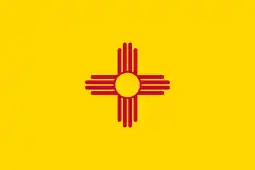Bizcochito
The bizcochito or biscochito (diminutive of the Spanish bizcocho) is a New Mexican cuisine crisp butter cookie, flavored with sugar, cinnamon, and anise.[2][3] The dough is rolled thin and cut into the shape of the fleur-de-lis, the Christian cross, a star, or a circle, symbolizing the moon.[4]
 A fresh batch of biscochitos | |
| Alternative names | Biscochito |
|---|---|
| Type | Cookie |
| Place of origin | Nuevo México, New Spain |
| Region or state | New Mexico, USA |
| Associated cuisine | New Mexican cuisine |
| Main ingredients | Butter or pork lard,[1] anise, cinnamon, flour |
The cookie was developed in New Mexico[5] over the centuries from the first Spanish colonists[6] of what was then known as Santa Fe de Nuevo México. The roots of this pastry date back as far as the Battle of Puebla in 1862, where French Emperor Maximilian was overthrown by the Mexicans. This date is now famously recognized in the United States as Cinco de Mayo, literally the "Fifth of May".[7]
Biscochitos are commonly served during celebrations such as wedding receptions, baptisms, and religious (especially Catholic) holidays, and frequently during the Christmas season.[2][8] They are also usually served with coffee.[8]
State cookie
In 1989, the U.S. State of New Mexico made the bizcochito its official state cookie,[8] making New Mexico the first U.S. state to have an official state cookie.[3][9] It was chosen to help maintain traditional home-baked cookery. To date, New Mexico remains one of only two states with a state cookie, alongside Massachusetts' chocolate-chip cookie.[10] Lupe Jackson, a New Mexican native, won first prize in a New England cookie contest in 2008 for her Bizcochito recipe—overcoming the Huckabees' snickerdoodles and the Romneys' Welsh skillet cakes.[11]

Cooking tips
Here are 8 tips by Lupe Jackson about improving the quality of bizcochitos:
- Use lard as shortening.
- Mix the dough with hands for a couple minutes past the point when the ingredients seem to have mixed together.
- Refrigerate the dough for several days before baking.
- Limit the handling of dough to keep it from toughening.
- Pat dough down with hand and finish with a rolling pin.
- Make cookies thick to add flavor. 3/8" dough will bake 1/2" cookie.
- Line cookie sheet with parchment. Bake at 350 degrees for 15–20 minutes.
- If cinnamon and sugar topping is desired, sprinkle it on while the cookie is still warm.[12]
References
- Hudgens, T. (2011). The Commonsense Kitchen: 500 Recipes + Lessons for a Hand-Crafted Life. Chronicle Books LLC. p. 542. ISBN 978-1-4521-0033-3. Retrieved January 26, 2015.
- Cobos, R. (2003). A Dictionary of New Mexico and Southern Colorado Spanish: Revised and Expanded Edition. Museum of New Mexico Press. p. 33. ISBN 978-0-89013-537-2. Retrieved January 26, 2015.
- "State Symbols". state.nm.us. Archived from the original on 7 July 2018. Retrieved 26 January 2015.
- "Biscochitos: a traditional New Mexico treat". Teresa Dovalpage: a Cuban writer's blog. October 18, 2016. Retrieved January 19, 2021.
- "NewMaxico, Biscochitos Recipe". Archived from the original on 11 February 2017. Retrieved 26 January 2015.
- Eisenstadt, P.; Belshaw, J. (2012). A Woman in Both Houses: My Career in New Mexico Politics. University of New Mexico Press. ISBN 978-0-8263-5025-1. Retrieved January 26, 2015.
- Mahoney, Jane (November 22, 2009). "Uniquely New Mexican; Many families eagerly await the Christmas bounty of posole, tamales and bizcochitos".
{{cite journal}}: Cite journal requires|journal=(help) - Brown, W.; Cogan, J. (2014). United Cakes of America: Recipes Celebrating Every State. ABRAMS. p. 305. ISBN 978-1-61312-795-7. Retrieved January 26, 2015.
- Smith, A.F. (2007). The Oxford Companion to American Food and Drink. Oxford Companions. Oxford University Press, USA. ISBN 978-0-19-530796-2. Retrieved January 26, 2015.
- "These cookies are official". Christian Science Monitor. ISSN 0882-7729. Retrieved 2023-01-27.
- "New Mexico's Favorite Cookie Wins Contest". The Santa Fe New Mexican. March 13, 2008. Retrieved 2022-11-25.
- Archives, Knolls (December 23, 2006). "A Recipe for Christmas".